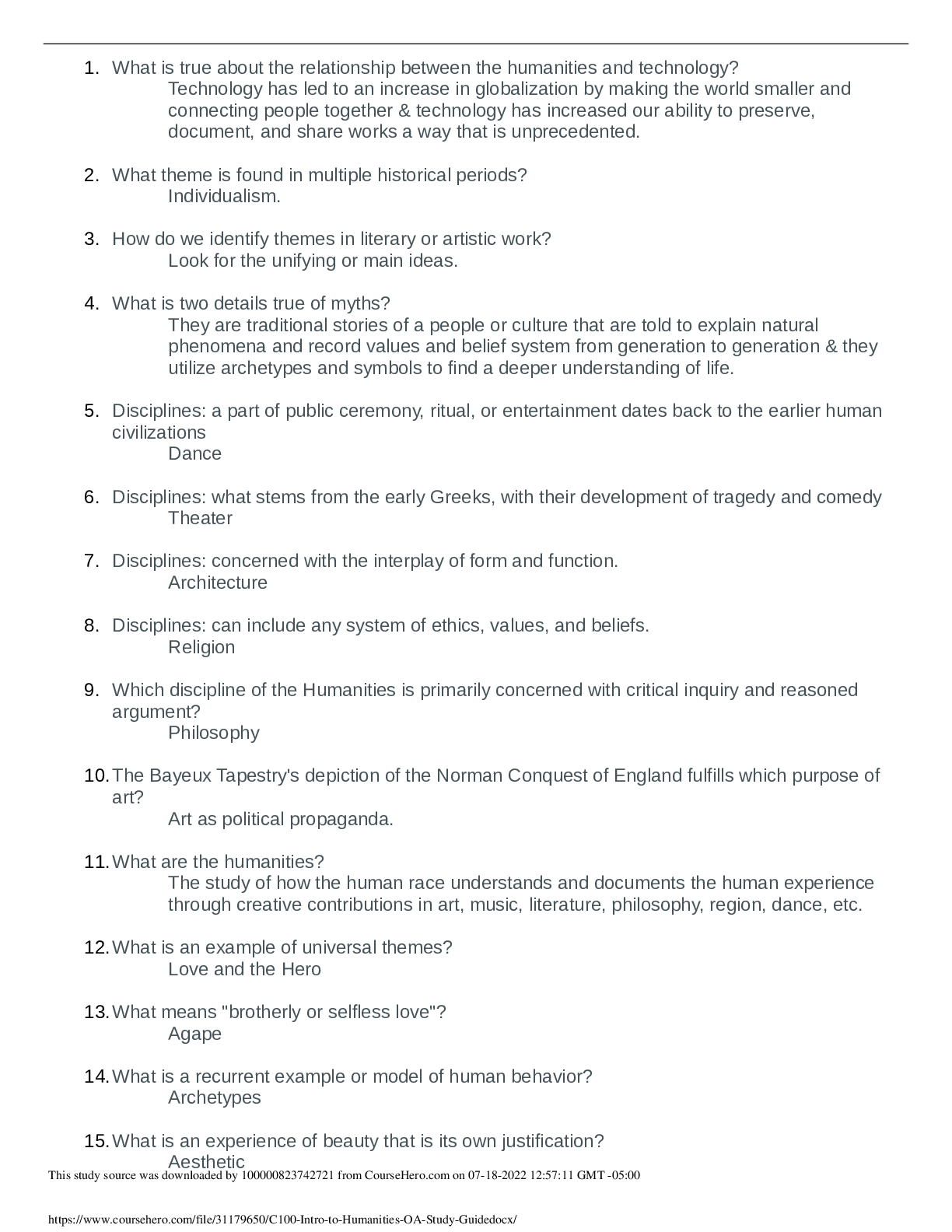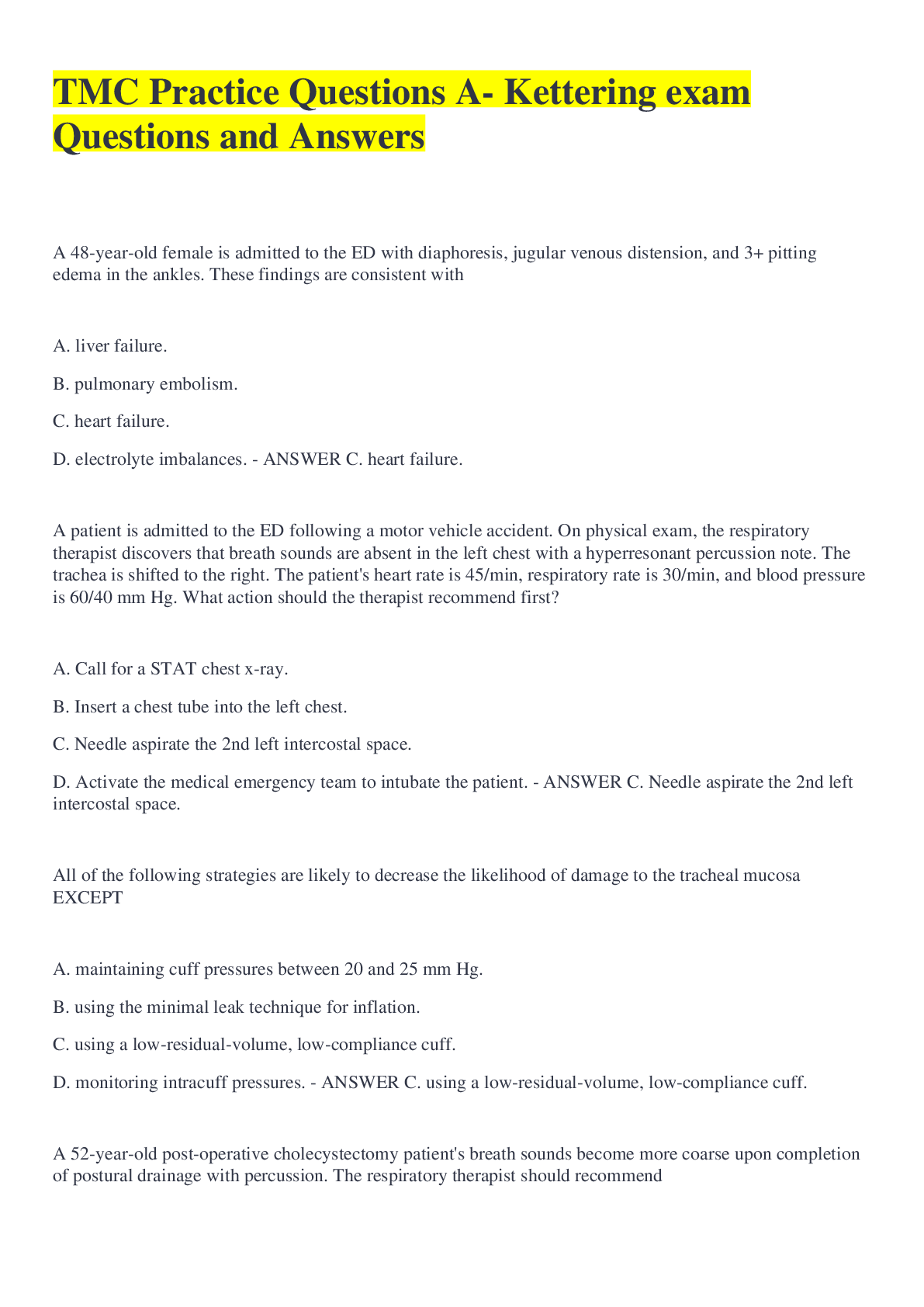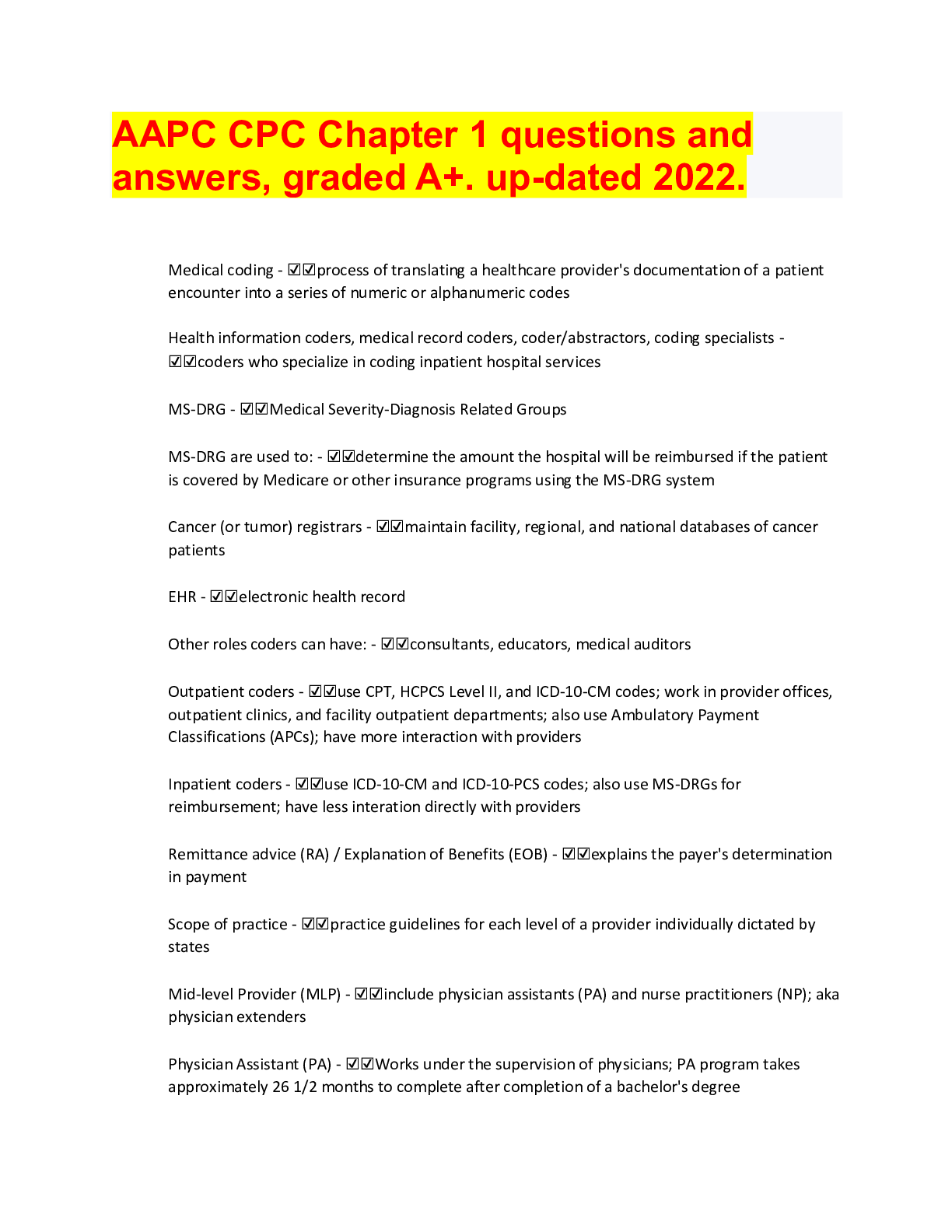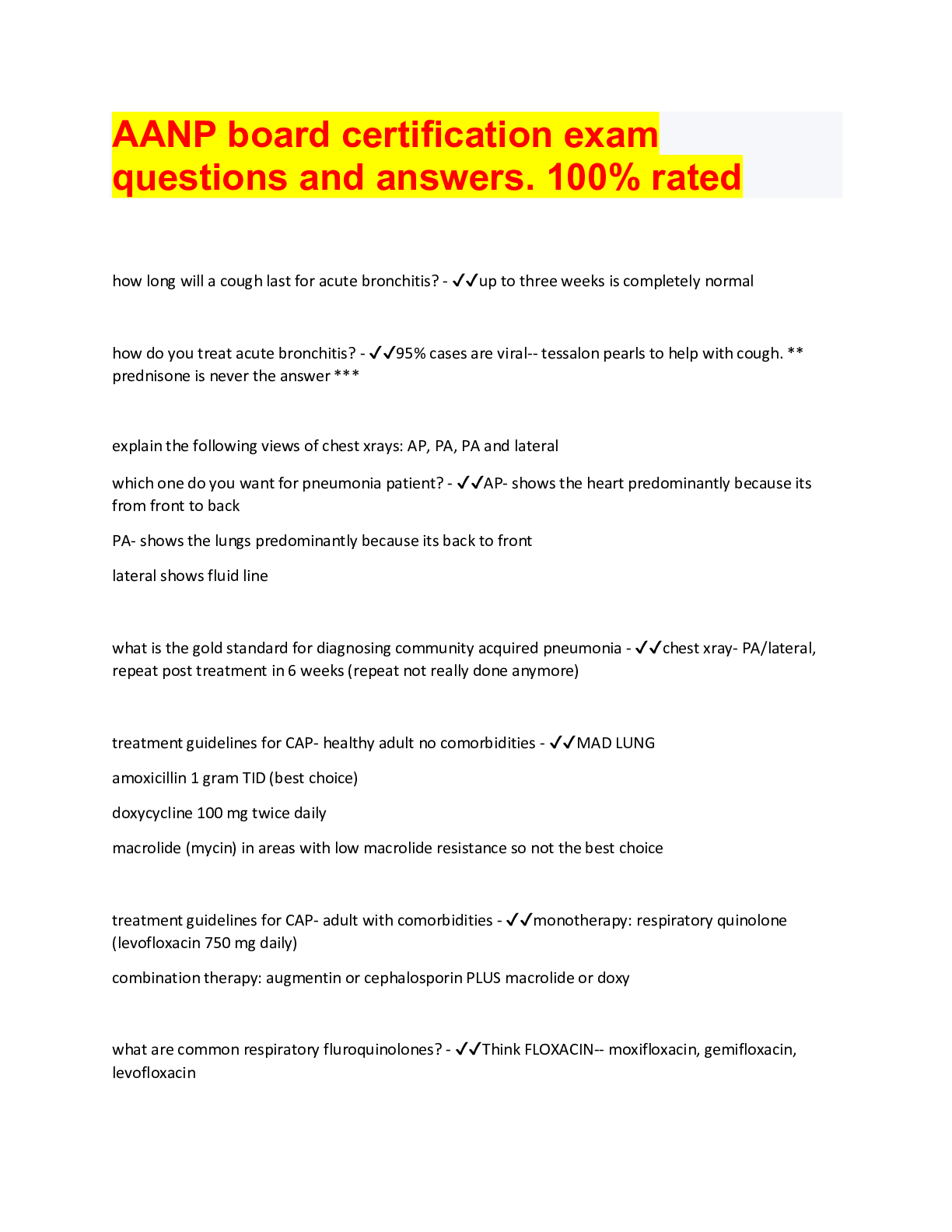*NURSING > QUESTIONS & ANSWERS > MED SURGE – Musculoskeletal. Questions and answers, Graded A+, 2022 (All)
MED SURGE – Musculoskeletal. Questions and answers, Graded A+, 2022
Document Content and Description Below
MED SURGE – Musculoskeletal. Questions and answers, Graded A+, 2022 The nurse is performing a musculoskeletal assessment of a patient in a nursing home who had a stroke 2 years ago and who has ... right-sided hemiplegia. The nurse notes that the girth of the patient's right calf is 2 inches less in diameter than the left calf. The nurse attributes the decreased girth to which of the following? a) Increased use of left calf muscle b) Atrophy of right calf muscle c) Edema in left lower extremity d) Bruising in right lower extremity - ✔✔b) Atrophy of right calf muscle Explanation: Girth of an extremity may increase due to exercise, edema, or bleeding into the muscle. However, a patient with right-sided hemiplegia is unable to use the right lower extremity. This patient may experience atrophy of the muscles from lack of use, which will result in a subsequent decrease in the girth of the calf muscle. Which of the following is an indicator of neurovascular compromise? a) Pain on active stretch b) Diminished pain c) Warm skin temperature d) Capillary refill of more than 3 seconds - ✔✔d) Capillary refill of more than 3 seconds Explanation: Capillary refill of more than 3 seconds is an indicator of neurovascular compromise. Other indicators include cool skin temperature, pale or cyanotic color, weakness, paralysis, paresthesia, unrelenting pain, pain on passive stretch, and absence of feeling. Cool skin temperature is an indicator of neurovascular compromise. Unrelenting pain is an indicator of neurovascular compromise. Pain on passive stretch is an indicator of neurovascular compromise. The nurse working in the orthopedic surgeon's office is asked to schedule a shoulder arthrography. The nurse determines that the surgeon suspects which of the following findings? a) Decreased bone density b) Fracture of the clavicle c) Tear in the joint capsule d) Injury to the radial nerve - ✔✔c) Tear in the joint capsule Explanation: Arthrography is useful in identifying acute or chronic tears of the joint capsule or supporting ligaments of the knee, shoulder, ankle, hip, or waist. X-rays are used to diagnose bone fractures. Bone densitometry is used to estimate bone mineral density. An electromyogram (EMG) provides information about the electrical potential of the muscles and nerves leading to them. The nurse is assessing a young girl during her school's annual sports physical. The assessment reveals that the girl has lateral curving of the spine. The nurse reports to the health care professional that the assessment revealed which of the following? a) Scoliosis b) Diaphysis c) Lordosis d) Epiphysis - ✔✔a) Scoliosis Explanation: Scoliosis is a lateral curving of the spine. Lordosis is an increase in the lumbar curvature of the spine. Diaphysis is the shaft of a long bone. Epiphysis is the end of a long bone. Which hormone inhibits bone reabsorption and increases calcium deposit in the bone? a) Calcitonin b) Growth hormone c) Sex hormones d) Vitamin D - ✔✔a) Calcitonin Explanation: Calcitonin, secreted by the thyroid gland in response to elevated blood calcium levels, inhibits bone reabsorption and increases the deposit of calcium in the bone. The other answers do not apply. Which of the following describes an osteon? a) A bone resorption cell b) A bone-forming cell c) A microscopic functional bone unit d) A mature bone cell - ✔✔c) A microscopic functional bone unit Explanation: The center of an osteon contains a capillary, a microscopic functional bone unit. An osteoblast is a bone-forming cell. An osteoclast is a bone resorption cell. An osteocyte is a mature bone cell. The nurse is conducting a community education program on hip fracture risk. The nurse evaluates that the participants understand the program when the program determines that the person at highest risk for a hip fracture is which of the following? a) High school football player b) 30-year-old pregnant woman c) Toddler just starting to walk d) 80-year-old widow - ✔✔d) 80-year-old widow Explanation: Hip fracture occurs with greater incidence in elderly people and is often a life-altering event that has a negative impact on the person's mobility and quality of life. Which nerve is being assessed when the nurses asks the patient to dorsiflex his ankle and extend his toes? a) Radial b) Median c) Peroneal d) Ulnar - ✔✔c) Peroneal Explanation: The motor function of the peroneal nerve is assessed by asking the patient to dorsiflex the ankle and to extend the toes, while pricking the skin between the great toe and center toe assesses the sensory function. The radial nerve is assessed by asking the patient to stretch out the thumb, then the wrist, and then the fingers at the metacarpal joints. The median nerve is assessed by asking the patient to touch the thumb to the little finger. Asking the patient to spread all fingers allows the nurse to assess motor function affected by ulnar innervation. A patient is exhibiting diminished range of motion, loss of flexibility, stiffness, and loss of height. The history and physical findings are associated with age-related changes of which area? a) Joints b) Muscles c) Ligaments d) Bones - ✔✔a) Joints Explanation: History and physical findings associated with age-related changes of the joints include diminished range of motion, loss of flexibility, stiffness, and loss of height. History and physical findings associated with age-related changes of bones include loss of height, posture changes, kyphosis, flexion of hips and knees, back pain, osteoporosis, and fracture. History and physical findings associated with age-related changes of muscles include loss of strength, diminished agility, decreased endurance, prolonged response time (diminished reaction time), diminished tone, a broad base of support, and a history of falls. History and physical findings associated with age-related changes of ligaments include joint pain on motion that resolves with rest, crepitus, joint swelling/enlargement, and degenerative joint disease (osteoarthritis). The homecare nurse is evaluating the musculoskeletal system of a geriatric patient whose previous assessment was within normal limits. The nurse initiates a call to the health care provider and/or emergency services when which of the following changes are found? a) Increased joint stiffness b) Decreased right-sided muscle strength c) Decreased flexibility d) Decreased agility - ✔✔b) Decreased right-sided muscle strength Explanation: Although symmetrical decreases in muscle strength can be a part of the aging process, asymmetrical decreases are not. The nurse should contact the health care provider when decreased right-sided muscle strength is found, as this could indicate a stroke or transient ischemic attack. Decreased flexibility, decreased agility, and increased joint stiffness are all part of the aging process and therefore do not require the nurse to contact the health care provider. Which nerve is assessed when the nurse asks the patient to spread all fingers? a) Median b) Peroneal c) Ulnar d) Radial - ✔✔c) Ulnar Explanation: Asking the patient to spread all fingers allows the nurse to assess motor function affected by ulnar innervation, while pricking the fat pad at the top of the small finger allows assessment of the sensory function affected by the ulnar nerve. The peroneal nerve is assessed by asking the patient to dorsiflex the ankle and to extend the toes. The radial nerve is assessed by asking the patient to stretch out the thumb, then the wrist, and then the fingers at the metacarpal joints. The median nerve is assessed by asking the patient to touch the thumb to the little finger. Which of the following terms refers to mature compact bone structures that form concentric rings of bone matrix? a) Cancellous bone b) Endosteum c) Trabecula d) Lamellae - ✔✔d) Lamellae Explanation: Lamellae are mineralized bone matrices. Endosteum refers to the marrow cavity lining of hollow bone. Trabecula refers to latticelike bone structure. Cancellous bone refers to spongy, latticelike bone structure. After a fracture, during which stage or phase of bone healing is devitalized tissue removed and new bone reorganized into its former structural arrangement? a) Reparative b) Inflammation c) Remodeling d) Revascularization - ✔✔c) Remodeling Explanation: Remodeling is the final stage of fracture repair. During inflammation, macrophages invade and débride the fracture area. Revascularization occurs within about 5 days after the fracture. Callus formation occurs during the reparative stage, but is disrupted by excessive motion at the fracture site. What is the term for a rhythmic contraction of a muscle? a) Crepitus b) Hypertrophy c) Clonus d) Atrophy - ✔✔c) Clonus Explanation: Clonus is a rhythmic contraction of the muscle. Atrophy is a shrinkagelike decrease in the size of a muscle. Hypertrophy is an increase in the size of a muscle. Crepitus is a grating or crackling sound or sensation that may occur with movement of ends of a broken bone or irregular joint surface. The nurse is reading the admission note of a patient with a bone fracture that requires surgery. The note indicates the presence of crepitus. The nurse interprets this as being which of the following? a) Closed fracture b) Ecchymosis c) Bleeding d) Crackling sound - ✔✔d) Crackling sound Explanation: Crepitus is a sound or sensation elicited by the rubbing together of fragments of bone, as in a fracture, or in irregular joint surfaces. The sound/sensation can be described as "grating" or "crackling." The nurse reading a patient's chart notices that the patient is documented to have paresthesia. The nurse plans care for a patient with which of the following? a) Absence of muscle tone b) Abnormal sensations c) Involuntary twitch of muscle fibers d) Absence of muscle movement suggesting nerve damage - ✔✔b) Abnormal sensations Explanation: Abnormal sensations, such as burning, tingling, and numbness, are referred to as paresthesias. The absence of muscle tone suggesting nerve damage is referred to as paralysis. A fasciculation is the involuntary twitch of muscle fibers. A muscle that holds no tone is termed flaccid. The nurse is conducting a musculoskeletal assessment of a patient in a nursing home. The patient is unable to dorsiflex his right foot or extend his toes. The nurse evaluates this finding as an injury to which of the following nerves? a) Femoral b) Achilles c) Sciatic d) Peroneal - ✔✔d) Peroneal Explanation: Injury to the peroneal nerve as a result of pressure may cause foot drop or the inability to dorsiflex the foot and extend the toes. The nurse is creating a teaching plan for a 65-year-old woman on prevention of osteoporosis. The nurse should include which of the following on the teaching plan? Select all that apply. a) Increased consumption of low-fat milk b) Increased consumption of fish c) Daily intake of 800 mg of calcium d) Daily intake of 1,000 IU of vitamin D - ✔✔a) Increased consumption of low-fat milk, b) Increased consumption of fish, d) Daily intake of 1, 000 IU of vitamin D Explanation: Diet is an essential component of maintaining adult bone mass and preventing osteoporosis. Recommended daily intake of calcium is 1,000-1,200 mg. Good sources of calcium include low-fat milk, yogurt, and cheese and calcium-fortified foods. To ensure absorption of calcium, vitamin D intake should range from 800-1,000 IU for adults over the age of 50. Good sources of vitamin D include vitamin D-fortified milk and cereals, egg yolks, saltwater fish, and liver. The nurse is evaluating a patient's peripheral neurovascular status. Which of the following should the nurse report to the health care provider as a circulatory indicator of peripheral neurovascular dysfunction? a) Cool skin b) Paralysis c) Weakness d) Paresthesia - ✔✔a) Cool skin Explanation: Indicators of peripheral neurovascular dysfunction related to circulation include pale, cyanotic, or mottled skin with a cool temperature. The capillary refill is more than 3 seconds. Weakness and paralysis are related to motion. Paresthesia is related to sensation. The nurse is caring for patient scheduled to have magnetic resonance imaging (MRI). The nurse contacts the health care provider to cancel the MRI when the nurse reads which of the following in the patient's medical history? a) Cochlear implant b) Tumor removal c) Colostomy d) Skin graft - ✔✔a) Cochlear implant Explanation: Nonremovable cochlear devices can become inoperable when exposed to MRI. Therefore, it is contraindicated for a patient with a cochlear implant to have an MRI. Also, transdermal patches (e.g., nicotine patch [NicoDerm], nitroglycerin transdermal [Transderm-Nitro], scopolamine transdermal [Transderm Scop], clonidine transdermal [Catapres-TTS]) that have a thin layer of aluminized backing must be removed before MRI because they can cause burns. The primary provider should be notified before the patches are removed. Additionally, the patient should remove all jewelry, hair clips, hearing aids, credit cards with magnetic strips, and other metal-containing objects; otherwise, these objects can become dangerous projectiles or cause burns. Which of the following terms refers to muscle tension being unchanged with muscle shortening and joint motion? a) Contracture b) Fasciculation c) Isometric contraction d) Isotonic contraction - ✔✔d) Isotonic contraction Explanation: Exercises such as swimming and bicycling are isotonic. Isometric contraction is characterized by increased muscle tension, unchanged muscle length, and no joint motion. Contracture refers to abnormal shortening of muscle, joint, or both. Fasciculation refers to the involuntary twitch of muscle fibers. The nurse working in the ER receives a call from the x-ray department communicating that the patient the nurse is caring for has a fracture in the shaft of the tibia. The nurse tells the physician that the patient's fracture is which of the following? a) Epiphysis b) Scoliosis c) Lordosis d) Diaphysis - ✔✔d) Diaphysis Explanation: The diaphysis is primarily cortical bone. An epiphysis is an end of a long bone. Lordosis refers to an increase in lumbar curvature of spine. Scoliosis refers to lateral curving of the spine. The nurse is assessing the muscle tone of a patient with cerebral palsy. Which of the following descriptions does the nurse determine to be an expected assessment of this patient's muscle tone? a) Flaccid b) Hypertonic c) Atonic d) Atrophied - ✔✔b) Hypertonic Explanation: In patients with conditions characterized by upper motor neuron destruction, such as in cerebral palsy, the muscles are often hypertonic. However, in conditions with lower motor neuron destruction, the muscles become atonic and/or atrophied and/or flaccid. During which stage or phase of bone healing after fracture does callus formation occur? a) Reparative b) Inflammation c) Remodeling d) Revascularization - ✔✔a) Reparative Explanation: Callus formation occurs during the reparative stage, but is disrupted by excessive motion at the fracture site. Remodeling is the final stage of fracture repair during which the new bone is reorganized into the bone's former structural arrangement. During inflammation, macrophages invade and débride the fracture area. Revascularization occurs within about 5 days after the fracture. The nurse is conducting a musculoskeletal assessment on a patient documented to have rheumatoid arthritis. Which of the following would the nurse anticipate finding when inspecting the patient's fingers? a) Hard nodules adjacent to the joints b) Hard nodules of bony overgrowth c) Soft nodules along the palmar surface d) Soft, subcutaneous nodules along the tendons - ✔✔d) Soft, subcutaneous nodules along the tendons Explanation: The subcutaneous nodules of rheumatoid arthritis are soft and occur within and along tendons that provide extensor function to the joints. The nodules of gout are hard and lie within and immediately adjacent to the joint capsule itself. Osteoarthritic nodules are hard and painless and represent bony overgrowth that has resulted from destruction of the cartilaginous surface of bone within the joint capsule. Which term describes a surgical procedure to release constricting muscle fascia so as to relieve muscle tissue pressure? a) Osteotomy b) Arthroplasty c) Arthrodesis d) Fasciotomy - ✔✔d) Fasciotomy Explanation: A fasciotomy is a surgical procedure to release constricting muscle fascia so as to relieve muscle tissue pressure. An osteotomy is a surgical cutting of bone. An arthroplasty is a surgical repair of a joint. Arthrodesis is a surgical fusion of a joint. A patient with a short arm cast is suspected to have compartment syndrome. What actions should the nurse include in the plan of care? Select all that apply. a) Provide support to the injured extremity. b) Assess neurovascular status every 8 hours. c) Elevate the arm above the heart. d) Apply ice to extremity. e) Prepare for cast removal. - ✔✔a) Provide support to the injured extremity., e) Prepare for cast removal. Explanation: The nurse should anticipate immediate removal of the cast and provide support to the injured extremity. Neurovascular status should be assessed more frequently than every 8 hours. If the patient is not showing improvement in the neurovascular status, then a fasciotomy may be needed. Waiting 8 hours to assess neurovascular status may cause permanent damage to the extremity. To promote arterial blood flow, the arm should be elevated to the heart level, not above. Ice should not be used as it could further decrease blood flow to the extremity. Which of the following orthopedic surgeries is done to correct and align a fracture after surgical dissection and exposure of the fracture? a) Arthrodesis b) Open reduction c) Joint arthroplasty d) Total joint arthroplasty - ✔✔b) Open reduction Explanation: An open reduction is the correction and alignment of the fracture after surgical dissection and exposure of the fracture. Arthrodesis is immobilizing fusion of a joint. A joint arthroplasty or replacement is the replacement of joint surfaces with metal or synthetic materials. A total joint arthroplasty is the replacement of both the articular surfaces within a joint with metal or synthetic materials. An unresponsive patient had a plaster cast applied 8 hours ago to the right lower leg. When moving the patient, the nurse notices an indentation on the posterior lower portion of the cast. What is the best action by the nurse? a) Remove the cast immediately. b) Assess for pedal pulse and mobility of toes. c) Notify the physician. d) Document the findings. - ✔✔c) Notify the physician. Explanation: Indentations in the cast can cause skin irritations and breakdown. The physician needs to be notified to assess the need for a new cast or manipulation of the current cast to prevent the skin breakdown. The nurse will need to document the findings and actions taken to resolve the issue but cannot document actions without completing an action, such as notifying the physician. The cast does not need immediate removal. Pedal pulse will indicate if a circulatory issue is present but with the patient being unresponsive, mobility of the toes cannot be assessed. Which would be consistent as a component of self-care activities for the patient with a cast? a) Place the casted extremity in a dependent position frequently. b) Use plastic hanger wrapped in gauze to scratch under the cast. c) Cushioning rough edges of the cast with tape d) Cover the cast with plastic to insulate it. - ✔✔c) Cushioning rough edges of the cast with tape Explanation: The patient can cushion rough edges with tape to prevent skin irritation. The cast should be kept dry, but do not cover it with plastic or rubber because this causes condensation, which dampens the cast and skin. The casted extremity is to be elevated to heart level frequently; a dependent position will increase swelling. A patient should not use any object to scratch under the cast. A patient is placed in traction for a femur facture. The nurse would document what as the expected outcomes of traction? Select all that apply. a) Full range of motion to extremity b) Realignment of a fracture c) Increased ability to bear weight d) Minimization of muscle spasms e) Decreased pedal pulse f) Reduction of deformity - ✔✔b) Realignment of a fracture, d) Minimization of muscle spasms, f) Reduction of deformity Explanation: Traction is used to minimize muscle spasms, to reduce, align, and immobilize fractures, and to reduce deformity. Traction does not allow for full range of motion or an increased ability to bear weight. The patient is confined to the bed while in traction. A decreased pulse is a sign of circulatory compromise and should be investigated and reported. The nurse teaches the patient which of the following interventions in order to avoid hip dislocation after replacement surgery? a) Never cross the affected leg when seated. b) Avoid placing a pillow between the legs when sleeping. c) Bend forward only when seated in a chair. d) Keep the knees together at all times. - ✔✔a) Never cross the affected leg when seated. Explanation: Crossing the affected leg may result in dislocation of the hip joint after total hip replacement. The patient should be taught to keep the knees apart at all times. The patient should be taught to put a pillow between the legs when sleeping. The patient should be taught to avoid bending forward when seated in a chair. A patient is being discharged home with a long arm cast. What education should the nurse include to prevent disuse syndrome in the arm? a) Repositioning the arm in the cast b) Proper use of a sling c) Abduction and adduction of the shoulder d) Use of isometric exercises - ✔✔d) Use of isometric exercises Explanation: Isometric exercises allow for use of the muscle without moving the bone. Doing isometric exercises every hour while the patient is awake will help prevent disuse syndrome. Proper use of a sling does not prevent disuse syndrome. The patient should not attempt to reposition the arm in the cast. Abduction and adduction of the shoulder will help the shoulder joint but does not require the use of muscles in the lower arm. Which of the following nursing actions would help prevent deep vein thrombosis in a patient who has had an orthopedic surgery? a) Instructing about using patient-controlled analgesia, if prescribed b) Instructing about exercise, as prescribed c) Applying cold packs d) Applying antiembolism stockings - ✔✔d) Applying antiembolism stockings Explanation: Applying antiembolism stockings helps prevent deep vein thrombosis (DVT) in a patient who is immobilized due to orthopedic surgery. Regular administration of analgesics controls and prevents escalation of pain while ROM exercises help in maintaining muscle strength and tone and prevent contractions. On the other hand, cold packs are applied to help reduce swelling and this does not prevent deep vein thrombosis. A patient in the emergency department is being treated for a wrist fracture. The patient asks why a splint is being applied instead of a cast. What is the best response by the nurse? a) "It is best if an orthopedic doctor applies the cast." b) "A splint is applied when more swelling is expected at the site of injury." c) "You would have to stay here much longer because it takes a cast longer to dry." d) "Not all fractures require a cast." - ✔✔b) "A splint is applied when more swelling is expected at the site of injury." Explanation: Splints are noncircumferential and will not compromise circulation when swelling is expected. A splint is applied to support and immobilize the injured joint. A fracture will experience swelling as part of the inflammation process. The patient would not have to stay longer if a fiberglass cast is applied. Fiberglass cast dry in approximately 30 minutes. An orthopedic doctor is not needed to apply the cast. Many nurses and technicians are trained in proper application of a cast. Some fractures may not be treated with a cast but it would not be appropriate to answer with this response because it does not reflect the actual reason for a splint being applied. Which device is designed specifically to support and immobilize a body part in a desired position? a) Brace b) Splint c) Traction d) Sling - ✔✔b) Splint Explanation: A splint may be applied to a fractured extremity initially until swelling subsides. A brace is an externally applied device to support a body part, control movement, and prevent injury. A sling is used to support an arm and traction is the use of a pulling force on a body part. Which of the following is the most effective cleansing solution to complete pin site care? a) Alcohol b) Chlorhexidine c) Betadine d) Hydrogen peroxide - ✔✔b) Chlorhexidine Explanation: Chlorhexidine solution is recommended as the most effective cleansing solution; however, water and saline are alternate choices. Hydrogen peroxide and Betadine solutions have been used, but they are believed to be cytotoxic to osteoblasts and may actually damage healthy tissue. What is the best action by the nurse to achieve the optimal outcomes when caring for a patient with a musculoskeletal disorder that is using a cast? a) Preparing the patient for cast application b) Assessing for neurovascular compromise c) Educating the patient on cast care and complications d) Providing effective pain control - ✔✔c) Educating the patient on cast care and complications Explanation: [Show More]
Last updated: 1 year ago
Preview 1 out of 54 pages
Instant download
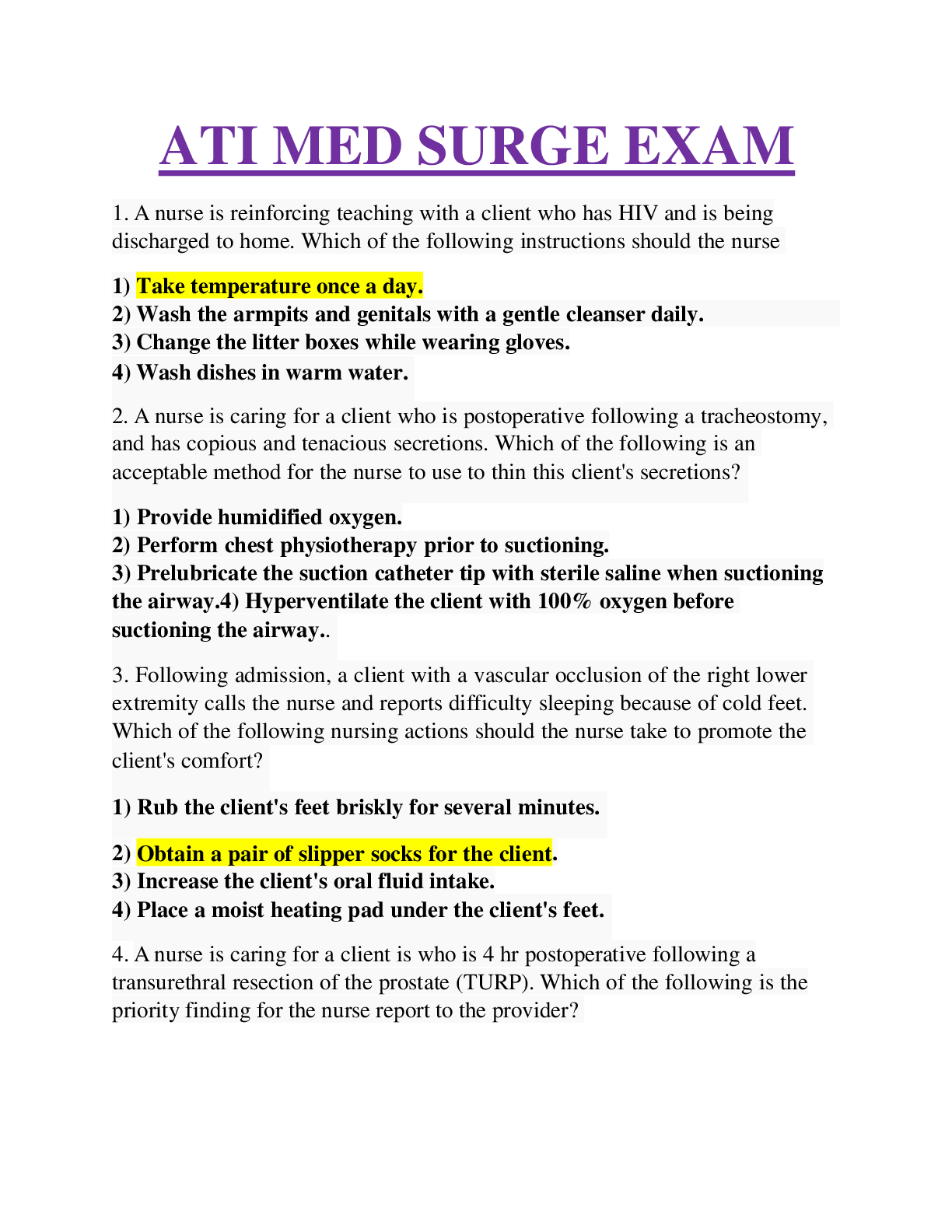
Buy this document to get the full access instantly
Instant Download Access after purchase
Add to cartInstant download
Reviews( 0 )
Document information
Connected school, study & course
About the document
Uploaded On
Aug 25, 2022
Number of pages
54
Written in
Additional information
This document has been written for:
Uploaded
Aug 25, 2022
Downloads
0
Views
38












.png)
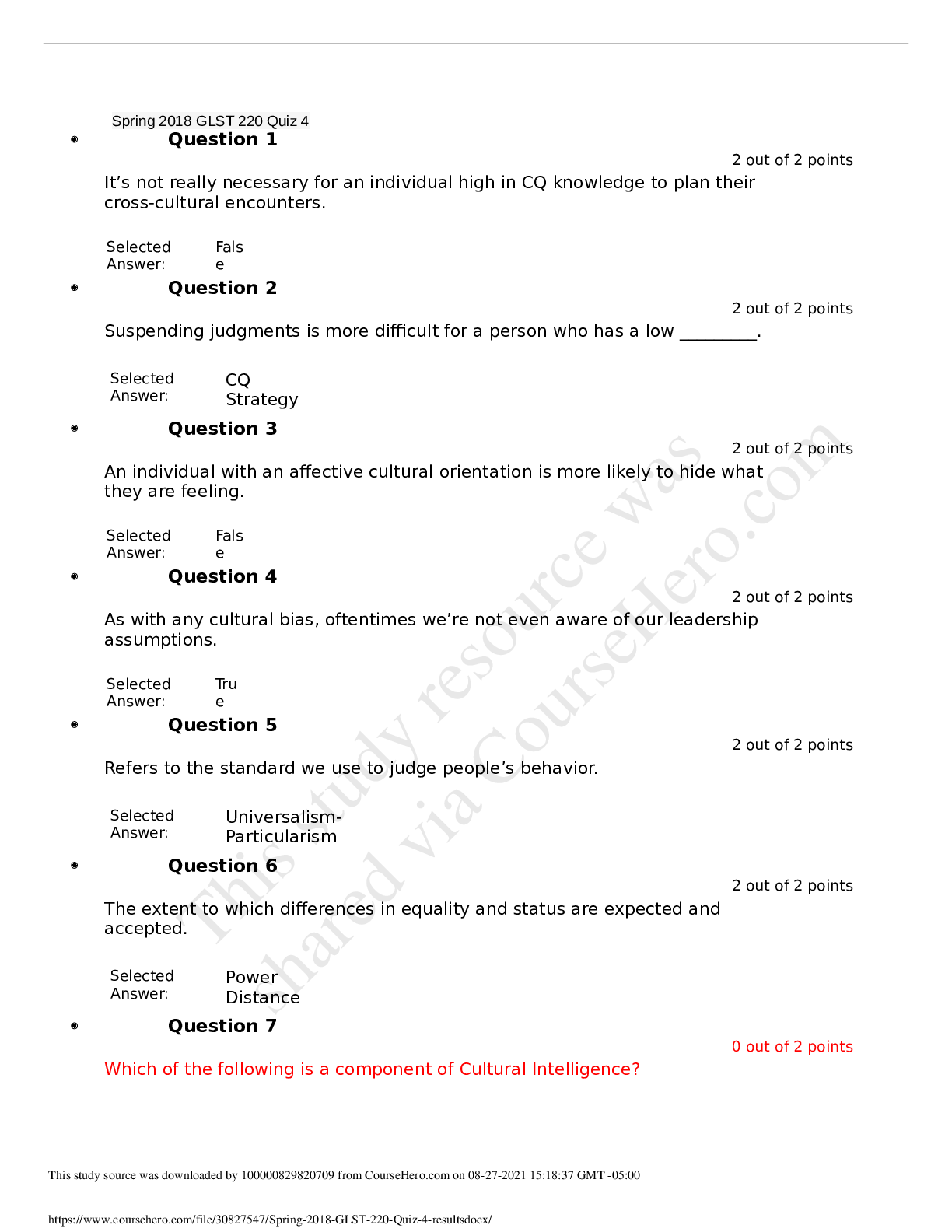
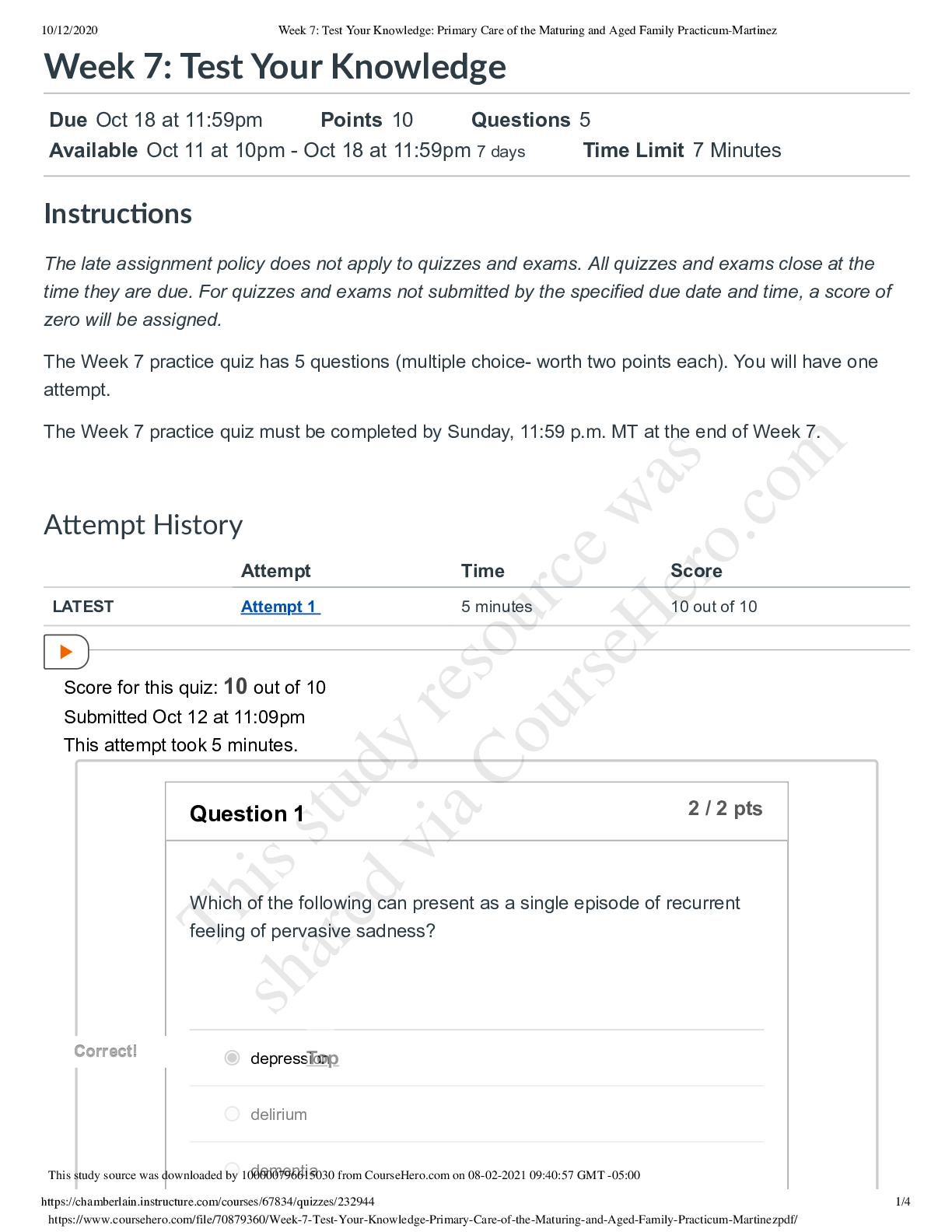


.png)
